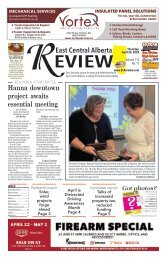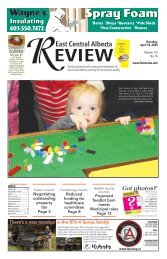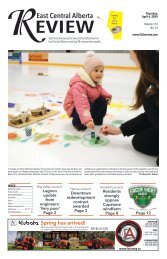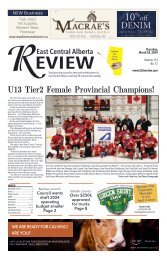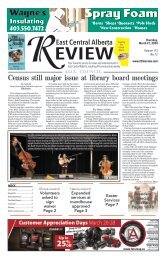Create successful ePaper yourself
Turn your PDF publications into a flip-book with our unique Google optimized e-Paper software.
12 <strong>The</strong> <strong>Chronicle</strong> February 26 - March <strong>18</strong>, 20<strong>19</strong> chronicle.durhamcollege.ca Campus<br />
Photograph by Janis Williams<br />
Elder Carolyn King, founder of the Moccasin Identifier Project, visited UOIT Feb. 5, to discuss the Indigenous initiative with future teachers.<br />
Future teachers get Indigenous education<br />
Janis Williams<br />
<strong>The</strong> <strong>Chronicle</strong><br />
Elder Carolyn King regularly visits<br />
schools Ontario-wide to deliver a<br />
message to students of the importance<br />
of Indigenous history. She<br />
spent her time in downtown Oshawa<br />
Feb. 5, with a first-year class of<br />
58 future elementary educators at<br />
the University of Ontario Institute<br />
of Technology (UOIT).<br />
King came to promote the Moccasin<br />
Identifier Project, an education<br />
and awareness initiative she<br />
created for the school system.<br />
<strong>The</strong> Mississaugas of the New<br />
Credit First Nation Elder says it is<br />
a “simple little program to educate<br />
all levels of school.”<br />
<strong>The</strong> concept is straightforward -<br />
education followed by an activity.<br />
Her goal is to introduce her program<br />
to schools across the province.<br />
Ideally, during the month of<br />
24<br />
HOURS<br />
DC UOIT<br />
June, students would learn about<br />
the traditional land and territories,<br />
King says.<br />
Schools would receive a kit filled<br />
with information and educational<br />
tools, including stencils of four<br />
unique sets of moccasins, which<br />
represent four First Nations - Cree,<br />
Nishnawbe, Huron-Wendat and<br />
Iroquois.<br />
<strong>The</strong>n students would mark their<br />
school’s territory by stencilling the<br />
moccasin, using washable paint, on<br />
school grounds, either outside on<br />
the pavement or on a wall.<br />
<strong>The</strong> symbol is a visual reminder<br />
of the traditional territory of Indigenous<br />
peoples, King says, who<br />
views the activity as both a conversation<br />
starter and a step in the<br />
right direction.<br />
<strong>The</strong> Elder’s hope is this education<br />
happens annually, so students<br />
“will forever know whose land they<br />
are on.”<br />
It’s a regular reminder of the<br />
traditional territory of Indigenous<br />
peoples, a concept King says is<br />
fragmented in the school system.<br />
King sees opportunity in reaching<br />
future educators because they<br />
will teach new generations.<br />
Her hope moving forward is children<br />
will turn into better informed<br />
adults.<br />
Kimberley Briggs, a current<br />
UOIT student and future primary/<br />
junior teacher, says she was moved<br />
by the Elder’s class visit.<br />
“It is important for us as new<br />
teachers to learn the real history of<br />
Canada and what better way than<br />
to hear it right from the mouths of<br />
those who lived it,” Briggs says.<br />
Following the presentation,<br />
Briggs says she feels “better armed<br />
to incorporate Indigenous perspectives<br />
into my classroom.”<br />
<strong>The</strong> Elder’s visit is one of many<br />
initiatives organized by the staff at<br />
UOIT’s Indigenous Education and<br />
Cultural Services.<br />
Indigenous programming specialist,<br />
Carol Ducharme, says the<br />
Moccasin Identifier Project is important<br />
on many levels.<br />
Ducharme says it not only encourages<br />
questions and engages<br />
dialogue, it also strengthens relationships<br />
for reconciliation between<br />
Indigenous and non-Indigenous<br />
people.<br />
“It is the responsibility for all<br />
Canadians to understand the history<br />
and impact of colonialism,”<br />
Ducharme says, “you cannot move<br />
towards any direction unless you<br />
first know where you are coming<br />
from.”<br />
For her part, King has served<br />
her First Nation community for<br />
35 years but her work continues<br />
by sharing her message – know the<br />
land where you stand.<br />
“I encourage that all people<br />
check to see whose first nation is<br />
in their land, what treaty land you<br />
are on or whose traditional territory<br />
you’re on,” says King.<br />
<strong>The</strong> Elder was speaking at<br />
UOIT’s Faculty of Education, 11<br />
Simcoe St. N. in Oshawa. UOIT<br />
sits on the lands of the people of the<br />
Mississaugas of Scugog Island First<br />
Nations, within the traditional territory<br />
of the Mississauga and in the<br />
territory covered by the Williams<br />
Treaties.<br />
Photograph by Janis Williams<br />
UOIT’s Indigenous Education and Cultural Services building in downtown Oshawa.<br />
Elder Carolyn King addresses a class of UOIT students.<br />
Photograph by Janis Williams







